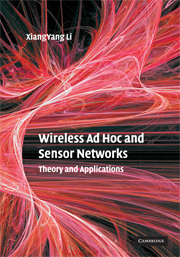Book contents
- Frontmatter
- Contents
- Preface
- Acknowledgments
- Abbreviations
- Part I Introduction
- Part II Wireless MACs
- Part III Topology Control and Clustering
- 7 Clustering and Network Backbone
- 8 Weighted Network Backbone
- 9 Topology Control with Flat Structures
- 10 Power Assignment
- 11 Critical Transmission Ranges for Connectivity
- 12 Other Transition Phenomena
- Part IV Wireless Network Routing Protocols
- Part V Other Issues
- Bibliography
- Index
9 - Topology Control with Flat Structures
from Part III - Topology Control and Clustering
Published online by Cambridge University Press: 06 July 2010
- Frontmatter
- Contents
- Preface
- Acknowledgments
- Abbreviations
- Part I Introduction
- Part II Wireless MACs
- Part III Topology Control and Clustering
- 7 Clustering and Network Backbone
- 8 Weighted Network Backbone
- 9 Topology Control with Flat Structures
- 10 Power Assignment
- 11 Critical Transmission Ranges for Connectivity
- 12 Other Transition Phenomena
- Part IV Wireless Network Routing Protocols
- Part V Other Issues
- Bibliography
- Index
Summary
Introduction
Unlike in traditional fixed infrastructure networks, there is no centralized control over ad hoc networks, which consist of an arbitrary distribution of radios in a certain geographical area. An important requirement of wireless ad hoc networks is that they should be self-organizing; i.e., transmission ranges and data paths are dynamically restructured with changing topology. Energy conservation and network performance are probably the most critical issues in wireless ad hoc networks because wireless devices are usually powered by batteries only and have limited computing capability and memory. Recently, significant research (Grünewald et al., 2002; L. Li et al., 2001; X.-Y. Li et al., 2001, 2002b; Rajaraman, 2002; Ramanathan and Rosales-Hain, 2000; Wang et al., 2003; Wattenhofer et al., 2001) has been conducted on designing a power-efficient network topology for wireless networks. Many research results applied a computational geometry technique (specifically, geometrical spanner) to achieve power efficiency. In this chapter, we review these approximation algorithms of a power spanner for ad hoc networks.
Ad Hoc Networks: Graph Model
A WAN consists of a set V of n wireless nodes distributed in a two-dimensional plane. Each node has the same maximum transmission range of R meters; e.g., a typical IEEE 802.11g WLAN adapter has a transmission range of around 100–500 m. By a proper scaling, we assume that all nodes have the maximum transmission range equal to one unit.
Information
- Type
- Chapter
- Information
- Wireless Ad Hoc and Sensor NetworksTheory and Applications, pp. 213 - 269Publisher: Cambridge University PressPrint publication year: 2008
